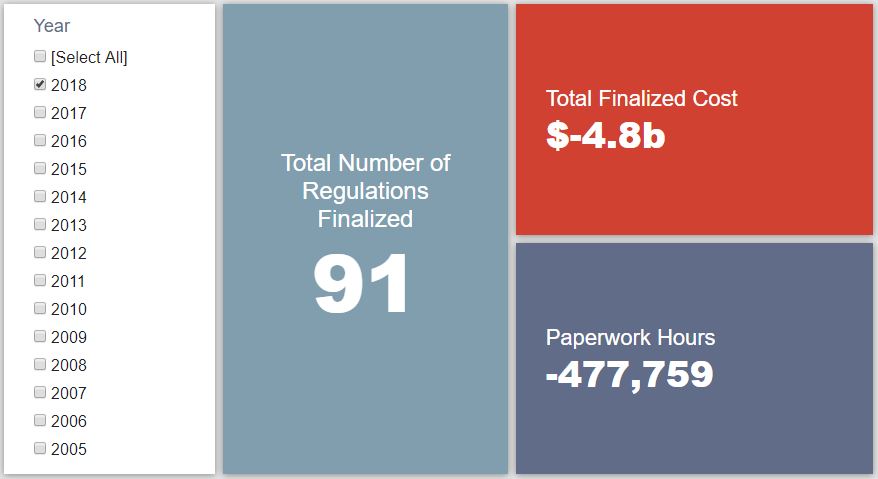Week in Regulation
May 14, 2018
A Busy Week in Proposed Rules
Last week was a big one for regulatory proposals. Out of 20 rulemakings that had economic estimates attached, 12 were proposed rules. Those 12 accounted for 99 percent of the week’s economic impact. Highlights included a handful of deregulatory health care actions and significant regulatory measures from the Securities and Exchange Commission (SEC). Between both proposed and final rules, agencies published roughly $6.3 billion in net costs and 97,946 hours of paperwork cuts. The per capita regulatory burden for 2018 is negative $14.57.
Regulatory Toplines
- New Proposed Rules: 61
- New Final Rules: 78
- 2018 Total Pages of Regulation: 21,959
- 2018 Final Rules: -$4.8 Billion
- 2018 Proposed Rules: $9.1 Billion
In terms of deregulatory proposals, the main item comes from the Department of the Interior. The proposed rule would make significant adjustments to “existing regulations for well control and blowout preventer systems,” saving nearly $1 billion ($98.6 annually). There was also a series of rulemakings out of the Centers for Medicare and Medicaid Services (CMS) setting the payment rates for various annual CMS spending programs for 2019. Across the four that include non-transfer estimates, CMS estimates that they could bring roughly $370 million in annual cost savings roughly 7 million fewer hours of paperwork.
However, a duo of regulatory proposals from SEC dwarfed the savings found in the above rulemakings. The proposed rules primarily focus on SEC implementing new requirements in the realm of investment advice as the Department of Labor begins to (at least partially) retreat from that area. Combined, the two rules with burden estimates could impose $7.5 billion in costs and nearly 7 million hours of new paperwork.
Tracking Regulatory Modernization
There was only final rule contributing savings towards the “regulatory budget” established under Executive Order (EO) 13,771. The Occupational Safety and Health Administration (OSHA) measure amends certain aspects of a January 2017 regulation regarding “Occupational Exposure to Beryllium.” OSHA estimates that this action could save affected entities roughly $370,000 per year.
According to AAF analysis, since the start of FY 2018 (beginning Oct. 1, 2017), executive agencies have promulgated 36 deregulatory actions with quantified cost savings against five regulatory measures that impose costs, under the rubric created by EO 13,771 and the administration’s subsequent guidance document on the matter. These rules combine for net annual savings of roughly $1.2 billion. This means that agencies have thus far surpassed the administration’s cumulative goal for FY 2018 of $687 million in net annual savings.
Click here to view AAF’s examination of the administration’s progress under the “one-in, two-out” executive order through the end of Fiscal Year 2017.
State of Major Obama-Era Initiatives
Based on total lifetime costs of the regulations, the Affordable Care Act has imposed costs of $52.9 billion in final state and private-sector burdens and 176.9 million annual paperwork hours.
Since passage, the Dodd-Frank financial reform legislation has produced more than 82.9 million final paperwork burden hours and imposed $38.9 billion in direct compliance costs.
Total Burdens
Since January 1, the federal government has published $4.4 billion in net costs (despite $4.8 billion in net savings from final rules) and new paperwork burdens amounting to 2.9 million hours (however, this includes 477,759 hours cut under final rules). Click here for the latest Reg Rodeo findings.











